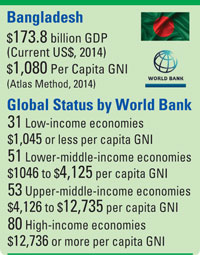
Steadying the path from LMIC to UMIC with lower income inequality
Sadiq Ahmed in continuation of his economic analysis | Wednesday, 15 July 2015

The primary reason for income inequality in a market economy is the unequal initial distribution of physical wealth and human capital. Unless checked and offset by corrective policies, this initial unequal distribution tends to get magnified as income grows because those endowed with better physical and human capital tend to acquire the best sources of income opportunities.
In a low income economy, poor governance also tends to exacerbate the income distribution problem through a political capture of governance and the rent-seeking behavior of the rich. The experience of Bangladesh (its income distribution pattern being reflected in Figure below) shows that both factors have contributed to a worsening of income distribution.
As Bangladesh enters a new development paradigm characterised by transition to a low middle income country (LMIC) status, there is an important opportunity to address its income distribution problem head on. Better income distribution can also contribute to higher growth both by building human capital of the population at large and by supporting entrepreneurship of the low-income mass through better access to physical capital. In this endeavour Bangladesh can learn from the positive experience of Western Europe, Canada and Japan.
Perhaps the most important lesson is the importance of investment in broad-based human capital. The attention given by these countries to education and training is a critical factor that explains how these countries have pursued successfully both higher income and better income distribution. Access to education and training created the opportunities for the poor to participate much better in the growth process. A major reflection of this priority is the amount of public spending on education. Sweden, Norway and Denmark spend 6.0-7.0% of gross domestic product (GDP) on education, while public education spending for France, UK, Canada and Germany is about 4.6-5.6% of gross domestic product (GDP). In comparison, public spending on education is only 1.8% of GDP in Bangladesh. The public spending challenge for education is obvious.
A second major lesson is the importance of public spending on health and social protection. France, Norway, Denmark, Sweden, Germany, UK and Japan spend between 12-19% of GDP on health and social protection spending. This large social spending is a tremendous source of financial support for the poor and vulnerable. In comparison, Bangladesh spends a mere 0.7% of GDP on health and another 1.7% on social protection.
A third lesson is that the underlying administrative structure in these countries ensures efficient use of these resources. The transfer payment mechanisms and administrative oversight prevents leakages and corruption in public spending. Where there is evidence of any wrong doing, swift actions are taken to correct them. This is a huge challenge in Bangladesh.
A fourth lesson relates to the financing of public programmes. Much of the spending happens from taxes and social security contributions of employees. In France, Sweden, Norway and Denmark, the tax to GDP ratios are in the 45-50% range. In Germany and UK, they are in the 35-40% range. Importantly, taxes on personal income account for the largest part of the tax revenues (between 25-35% of total tax collections). The setting up of a progressive and universally taxable personal income is a major feature of the tax system in these countries that plays an important redistributive role. In contrast, Bangladesh collects less than 10% of GDP in taxes, of which personal income taxes account for only 10-12%. Legal exemptions and concessions, along with poor tax administration, allow the large bulk of personal income to escape taxation.
Given the large size of the country and the low level of per capita income, it is not realistic to expect Western European, Japanese or Canadian standards of public spending, taxation and governance in Bangladesh. On the other hand, Bangladesh must not continue to pursue an inequitable development path. The lessons of experience of these low-inequality developed countries provide important insights about how Bangladesh might proceed to attack the inequality challenge. I have written several articles in the past where I show that a feasible reform of fiscal policy can yield an additional 4.0-5.0% of GDP from tax resources over the next five years that can be used to augment public spending on health, education and social protection.
This effort can deepen progressively over time to bring Bangladesh at a stage where tax revenues are in the 18-20% of GDP, personal income taxes are 7.0-8.0% of GDP, and public spending on health, education and social spending is in the 8.0-10% of GDP range. This fiscal scenario along with administrative improvements to cut waste and corruption in public spending can put LMIC Bangladesh on the path of an upper middle income country (UMIC) along with lower income inequality. Prosperity can and must be shared to make it sustainable over the longer term.
[The writer is Vice Chairman of the Policy Research Institute of Bangladesh (PRI,B). He is also the co-anchor of The Financial Express (FE)-PRI Economic Analysis Unit (EAU). He can be reached at [email protected]]